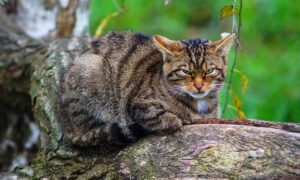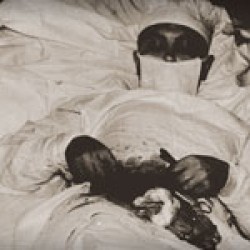It’s been 29 years since the Tasmanian government declared the Thylacine (Tasmanian Tiger) extinct (1986).
And the International Union for Conservation of Nature declared it extinct in 1982, 33 years ago. But people still report sighting and not a month goes by without a blurry photo appear online claiming to show proof of their existence.
The Thylacine held the status of endangered species until the 1980s. International standards at the time stated that an animal could not be declared extinct until 50 years had passed without a confirmed record. Since no definitive proof of the thylacine’s existence in the wild had been obtained for more than 50 years, it met that official criterion and was declared extinct by the International Union for Conservation of Nature in 1982 and by the Tasmanian government in 1986. The species was removed from Appendix I of the Convention on International Trade in Endangered Species of Wild Fauna and Flora (CITES) in 2013.
Major Thylacine Searches Since 1936
[one_third]
1937 – 38
State Fauna Board of Tasmania west and north west.
Possible footprints found. No Thylacines seen.
Sanctuaries recommended but not established.
[/one_third]
[one_third]
1945 – 46
David Fleay
From Jane River to Lake St Clair. Traps and snares used.
Possible footprints found.
No Thylacines seen.
[/one_third]
[one_third_last]
1959 – 61
Eric Guiler
‘Woolnorth’, north west. Automatic cameras used.
Possible Thylacine footprints found.
No Thylacines seen or filmed.
[/one_third_last]
[clear]
[one_third]
1963 – 64
Eric Guiler
North west. Any captured Thylacine to be relocated to Maria Island off Tasmania’s east coast.
Many animals caught but no Thylacines.
[/one_third]
[one_third]
1968 – 72
Jeremy Griffith, James Malley and Dr Bob Brown (Thylacine Expeditionary Research Team)
Many sightings recorded from the public.
25 automatic cameras deployed. The largest search to date.
No Thylacines found.
[/one_third]
[one_third_last]
1978 – 81
National Parks & Wildlife Service with Eric Guiler funded by the World Wildlife Fund
Automatic cameras extensively used.
No evidence of Thylacines found.
[/one_third_last]
[clear]
[one_third]
1982 – 83
Nick Mooney, Tasmanian Parks and Wildlife officer
Arthur River area
In response to a sighting by Wildlife officer Hans Naarding.
No evidence of Thylacines found.
Last known Government- sponsored search for the Thylacine.
[/one_third]
[one_third]
2005
Reward of $1.25 million offered by The Bulletin for conclusive proof of the Thylacine’s existence.
Reward never claimed.
Link to article.
[/one_third]
[one_third_last]
2006 – present
Unofficial, private searches continue to this day.
[/one_third_last]
[clear]
[divider]
[youtube]https://www.youtube.com/watch?v=K4Q9rJYvQ4M[/youtube]
Video from the Today, Australian breakfast television.
[clear]
[divider]

The thylacine, Thylacinus cynocephalus, Greek for “dog-headed pouched one” was the largest known carnivorous marsupial of modern times. It is commonly known as the Tasmanian tiger (because of its striped lower back) or the Tasmanian wolf. Native to continental Australia, Tasmania and New Guinea, it is believed to have become extinct in the 20th century. It was the last extant member of its family, Thylacinidae; specimens of other members of the family have been found in the fossil record dating back to the early Miocene.
The thylacine had become extremely rare or extinct on the Australian mainland before British settlement of the continent, but it survived on the island of Tasmania along with several other endemic species, including the Tasmanian devil. Intensive hunting encouraged by bounties is generally blamed for its extinction, but other contributing factors may have been disease, the introduction of dogs, and human encroachment into its habitat. Despite its official classification as extinct, sightings are still reported, though none has been conclusively proven.
Surviving evidence suggests that it was a relatively shy, nocturnal creature with the general appearance of a medium-to-large-size dog, except for its stiff tail and abdominal pouch (which was reminiscent of a kangaroo) and a series of dark transverse stripes that radiated from the top of its back (making it look a bit like a tiger).
[youtube]https://www.youtube.com/watch?v=HBeAI5Vbl4A[/youtube]
Compilation of all five known Australian silent films, shot in Hobart Zoo, Tasmania.
Like the tigers and wolves of the Northern Hemisphere, from which it obtained two of its common names, the thylacine was an apex predator. As a marsupial, it was not closely related to these placental mammals, but because of convergent evolution it displayed the same general form and adaptations. Its closest living relative is thought to be either the Tasmanian devil or numbat. The thylacine was one of only two marsupials to have a pouch in both sexes (the other being the water opossum). The male thylacine had a pouch that acted as a protective sheath, covering his external reproductive organs while he ran through thick brush. The thylacine has been described as a formidable predator because of its ability to survive and hunt prey in extremely sparsely populated areas.
The thylacine is a candidate for cloning and other molecular science projects due to its recent demise and the existence of several well preserved specimens.
Source: Wikipedia, Today and Queen Victoria Museum.





















